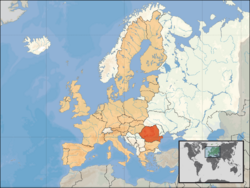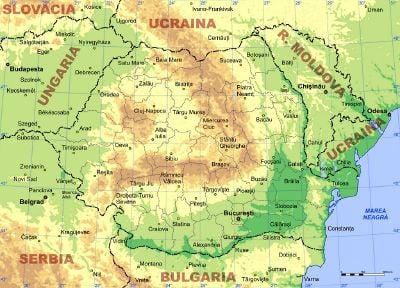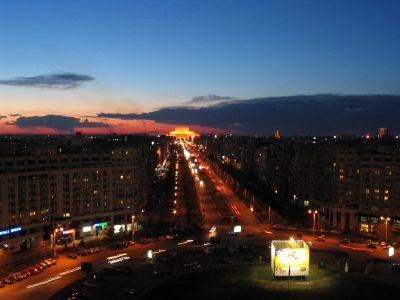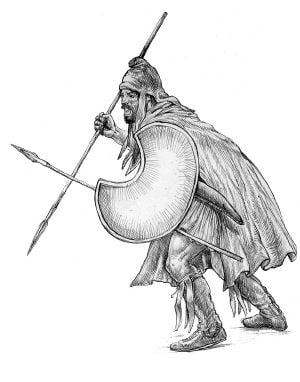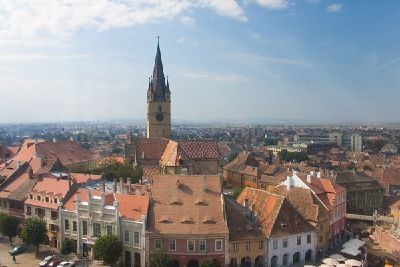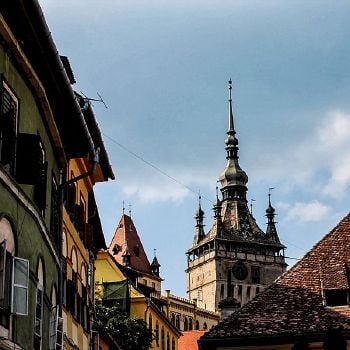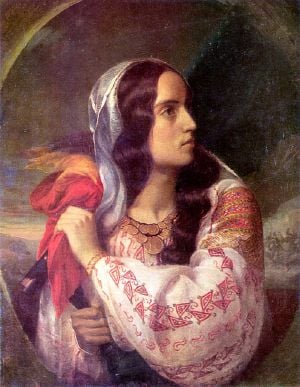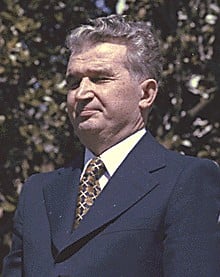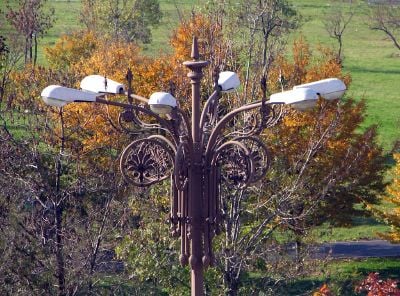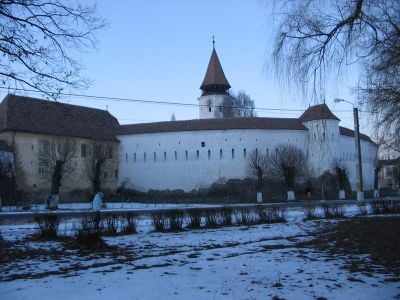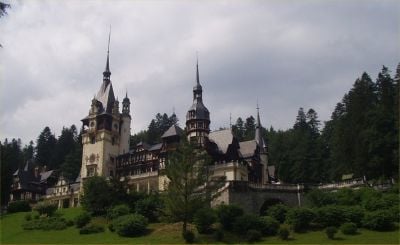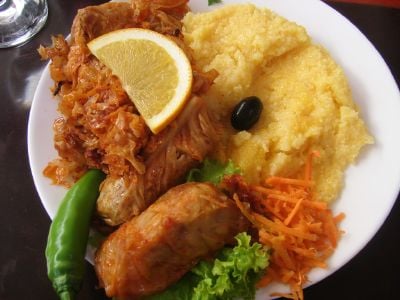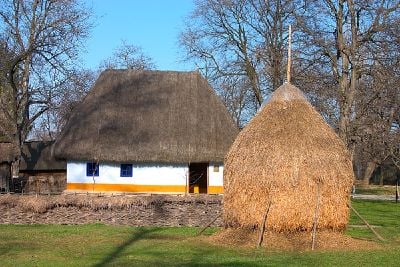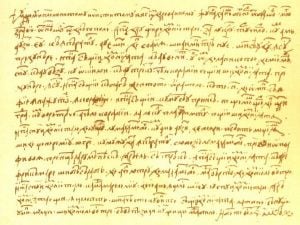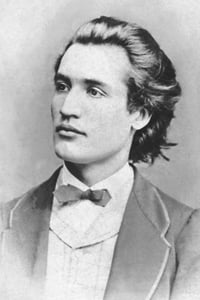Romania
| România Romania |
||||||
|---|---|---|---|---|---|---|
|
||||||
| Anthem: Deşteaptă-te, române! Awaken thee, Romanian! |
||||||
| Location of Romania (orange) – on the European continent (camel white) – in the European Union (camel) [Legend] |
||||||
| Capital (and largest city) | Bucharest 44°25′N 26°06′E | |||||
| Official languages | Romanian | |||||
| Ethnic groups (2011) | 83.4% Romanians 6.1% Hungarians 3.1% Roma 0.3% Ukrainians 0.2% Germans 6.8% Other/Unspecified[1] |
|||||
| Demonym | Romanian | |||||
| Government | Unitary semi-presidential republic | |||||
| - | President | Klaus Iohannis | ||||
| - | Prime Minister | Nicolae Ciucă | ||||
| Legislature | Parlamentul României | |||||
| - | Upper House | Senate | ||||
| - | Lower House | Chamber of Deputies | ||||
| Formation | ||||||
| - | Little Union1 | January 24, 1859 | ||||
| - | Independence from the Ottoman Empire2 | 1877/1878 | ||||
| - | Great Union3 | December 1, 1918 | ||||
| - | Socialist Republic | 30 December 1947 | ||||
| - | Current state form | 27 December 1989[2] | ||||
| EU accession | January 1, 2007 | |||||
| Area | ||||||
| - | Total | 238,391 km² (83rd) 92,043 sq mi |
||||
| - | Water (%) | 3 | ||||
| Population | ||||||
| - | 2021 estimate | |||||
| - | 2011 census | 20,121,641 (58th) | ||||
| - | Density | 80.4/km² (136th) 218.6/sq mi |
||||
| GDP (PPP) | 2021 estimate | |||||
| - | Total | |||||
| - | Per capita | |||||
| GDP (nominal) | 2021 estimate | |||||
| - | Total | |||||
| - | Per capita | |||||
| Gini (2020) | 33.8[5] | |||||
| Currency | Romanian leu4 (RON) |
|||||
| Time zone | EET (UTC+2) | |||||
| - | Summer (DST) | EEST (UTC+3) | ||||
| Internet TLD | .ro5 | |||||
| Calling code | [[+40]] | |||||
| 1 The Little Union refers to the double election of Alexander John Cuza in Wallachia and Moldavia (January 5, respectively January 24, 1859). 2 Independence proclaimed on May 9, 1877, internationally recognized in 1878. 3 The Great Union was the union of Romania with Bessarabia, Bukovina and Transylvania in 1918 and the creation of Greater Romania. 4 The leu was redenominated on July 1, 2005. As of that date 10,000 (old) lei (ROL) = 1 (new) leu (RON). 5 The .eu domain is also used, as in other European Union member states. |
||||||
Romania is a country in Southeastern Europe bordering Hungary and Serbia to the west, Ukraine and Moldova to the northeast, and Bulgaria to the south.
Many Romanians take pride in being the most eastern Romance people, completely surrounded by non-Latin peoples ("a Latin island in a Slavic sea").
The modern state of Romania was formed by the merging of the Danubian Principalities of Moldavia and Wallachia in 1859. The state united with Transylvania in 1918.
Romania's fascist government during the Second World War was responsible for the deportations to concentration camps and executions of between 280,000 to 380,000 Jews.
During the period of Soviet rule, Romania's resources were drained, and there were hundreds of thousands of abuses, deaths and incidents of torture against a large range of people, from political opponents to ordinary citizens.
The nation is also known for the despot Nicolae Ceauşescu who developed a cult of personality, deepened the country's communist police state, and imposed policies that impoverished Romanians and exhausted the economy.
Romania is poorer than other European Union nations, but it has a rich and varied culture. Moldavia is known for its painted churches, with their fine exterior and interior frescoes. Romanian folk tales and poems are about love, faith, kings, princesses, and witches. Transylvania is the location of the story of Dracula, based on the local tradition of vampires.
Geography
The name "Romania," first used in 1859, reflects the influence of ancient Rome on the nation's language and culture. Before the nineteenth century, Romanian documents use interchangeably two spelling forms: Român and Rumân.
With a surface area of 92,043 square miles (238,391 km²), Romania is the largest country in southeastern Europe and the 12th-largest in Europe, or slightly smaller than Oregon in the United States. Situated in the northeastern portion of the Balkan Peninsula, the country is halfway between the equator and the North Pole and equidistant from the westernmost part of Europe—the Atlantic Coast—and the most easterly—the Ural Mountains.
The Danube river forms a large part of Romania's border with Serbia and Bulgaria, is joined by the Prut River, which forms the border with the Republic of Moldova, and flows into the Black Sea on Romanian territory, forming the Danube Delta, the largest delta in Europe, which is a biosphere reserve and World Heritage-listed site due to its biodiversity. Other significant rivers are the Siret, running vertically through Moldavia, the Olt, running from the oriental Carpathian Mountains to Oltenia, the Tisa, marking a part of the border between Romania and Hungary, the Mureş, running through Transylvania from East to West, and the Someş.
The Danube is an important water route for domestic shipping, as well as international trade. It is navigable for river vessels along its entire Romanian course and for sea-going ships as far as the port of Brăila. It is also important for the production of hydroelectric power, at one of Europe's largest hydroelectric stations located at the Iron Gates, where the Danube surges through the Carpathian gorges.
Romania's terrain is distributed roughly equally between mountainous, hilly and lowland territories. The Carpathian Mountains dominate the centre of Romania, with 14 of its peaks reaching above the altitude of 6500 feet (2000 metres). The highest mountain is Moldoveanu Peak, at 8346 feet (2544 meters). In south-central Romania, the Carpathians soften into hills, towards the Bărăgan Plains.
Because of its position on the south-eastern portion of the European continent, Romania has a climate that is transitional between temperate and continental. In the extreme southeast, Mediterranean influences offer a milder, maritime climate. In Bucharest, the temperature ranges from -20.2°F (-29°C) in January to 84.2°F (29°C) in July. Rainfall, although adequate throughout the country, decreases from west to east and from mountains to plains. Some mountainous areas receive about 40 inches (1010 millimeters) of precipitation each year. Annual precipitation averages about 25 inches (635mm), in central Transylvania, and only 15 inches (381 millimeters) at Constanţa on the Black Sea.
Romania has a stretch of coast along the Black Sea, and the eastern and southern Carpathian Mountains run through its center.
Romania's geographical diversity has led to an accompanying diversity of flora and fauna. The country has the largest brown bear population in Europe, while chamois, lynx, wild cats, martens, and capercaillies are also known to live in the Carpathian Mountains.
Natural resources include petroleum (reserves declining), timber, natural gas, coal, iron ore, salt, arable land, and hydro power.
Natural hazards include earthquakes, which are most severe in south and southwest. The geological structure and climate results in numerous landslides.
Its capital and largest city is Bucharest, which with 2,082,334 inhabitants, is the sixth largest city in the European Union. Located in the southeast, it is the industrial and commercial center of Romania. Since 1459, it has gone through a variety of changes, becoming the state capital of Romania in 1862, and steadily consolidating its position as the center of the Romanian mass media, culture and arts. Its eclectic architecture is a mix of historical, interbellum, Communist-era and modern. In the period between the two World Wars, the city's elegant architecture and the sophistication of its elite earned Bucharest the nickname of the "Paris of the East" or "Little Paris." Other cities are: Iaşi with 320,888 people, Cluj-Napoca with 318,027, Timişoara with 317,660, and Constanţa with 310,471.
History
The territory of Romania has been inhabited by different groups of people since prehistory. In 2002, the oldest modern human (Homo sapiens) remains in Europe, were discovered in a cave near Anina, Romania. Nicknamed "John of Anina," his remains (the lower jaw) are approximately 42,000 years old.
Dacians
The Getae or Dacians, a Thracian tribe inhabited the territory of today's Romania since at least 513 B.C.E. Under the leadership of Burebista (70-44 B.C.E.) the Dacians became a powerful state which threatened the regional interests of the Romans. Julius Caesar intended to start a campaign against the Dacians, but was assassinated in 44 B.C.E. A few months later, Burebista shared the same fate, assassinated by his own noblemen. His powerful state was divided into four and did not become unified again until 95 B.C.E. under the reign of the Dacian king Decebalus. The Dacian state sustained a series of conflicts with the expanding Roman Empire, and was finally conquered in 106 C.E. by the Roman emperor Trajan.
The Gothic and Carpian campaigns in the Balkans during 238–269 C.E. (from the beginning of the period of military anarchy to the battle of Naissus), forced the Roman Empire to reorganize a new Roman province of Dacia south of the Danube, inside former Moesia Superior. In either 271 or 275 C.E., the Romans left Dacia, which was invaded by the Goths.
Dark Ages
The Goths lived with the local people until 378 C.E., when another nomadic people, the Huns, arrived and stayed until 435. The Gepids and the Eurasian Avars ruled Transylvania until the eighth century, after which the Bulgarians included the region in the First Bulgarian Empire until 1018.
Middle Ages
Many small local states with varying degree of independence developed, but only in the fourteenth century the larger principalities of Moldavia and Wallachia emerged to fight the Ottoman Turks, who conquered Constantinople in 1453. By 1541, the entire Balkan Peninsula and most of Hungary became Ottoman provinces. In contrast, Moldavia, Wallachia, and Transylvania, came under Ottoman suzerainty, but retained internal autonomy and, until the eighteenth century, some external independence.
By the eleventh century, the area of today's Transylvania became a largely autonomous part of the Kingdom of Hungary. Hungarian rulers invited the Székely, the Teutonic Order, and the Transylvanian Saxons, to settle in Transylvania. Basarab I founded the Romanian principality of Wallachia during the thirteenth century, and Dragoş founded Moldavia during the fourteenth century.
In 1475, Stephen III ("the Great") of Moldavia scored a decisive victory against the Ottoman Empire at the Battle of Vaslui. But Wallachia came under the suzerainty of the Ottoman Empire in 1476, and Moldavia in 1514. In 1541, Transylvania became a multi-ethnic principality under the suzerainty of the Ottoman Empire following the Battle of Mohács. Michael the Brave (1558-1559 - August 1601) was the Prince of Wallachia (1593-1601), of Transylvania (1599-1600), and of Moldavia (1600). During his reign the three principalities largely inhabited by Romanians were for the first time united under a single rule. But the chance for a unity dissolved after Michael was killed, only one year later, by the soldiers of a Habsburg (Austrian) army general Giorgio Basta.
Early Modern Romania
In 1699, Transylvania became a territory of the Habsburg's Austrian empire, following the Austrian victory over the Turks. The Austrians, in their turn, rapidly expanded their empire: in 1718 an important part of Wallachia, called Oltenia, was incorporated to the Austrian monarchy and was only returned in 1739.
In 1775, the Habsburg Monarchy annexed the northern part of Moldova, Bukovina, and the Ottoman Empire its south-eastern part, Budjak. In 1812 the Russian Empire annexed its eastern half, Bessarabia.
National awakening
As in most European countries, 1848 brought revolution to Moldavia, Wallachia, and Transylvania, announced by Tudor Vladimirescu and his Pandurs in the Wallachian uprising of 1821. The goals of the revolutionaries - complete independence for Moldavia and Wallachia, and national emancipation in Transylvania - remained unfulfilled, but the uprising helped the three principalities recognize unity of language and interests.
Heavily taxed and badly administered under the Ottoman Empire, in 1859, people in both Moldavia and Wallachia elected the same domnitor (ruler) - Alexander John Cuza - as prince. Cuza led an agricultural reform, distributing land to poor and attracting enemies. Via an 1866 coup d'etat, also known as the Abominable Revolution, Cuza was exiled and replaced by Prince Karl of Hohenzollern-Sigmaringen, who became known as Prince Carol I of the Principality of Romania.
The old kingdom
In 1877, Romania declared independence from the Ottoman Empire and, following a Russian-Romanian-Turkish war, in which Romania fought on the Russian side, Romania’s independence was recognized by the Treaty of Berlin, 1878, making it the first independent national state in eastern Europe. In return for ceding to Russia the three southern districts of Bessarabia that had been regained by Moldavia after the Crimean War in 1852, the Kingdom of Romania acquired Dobruja. On March 26, 1881, the principality was raised to a monarchy and Prince Carol became King Carol I of Romania (1839-1914). The new state, squeezed between the great powers of the Ottoman, Austro-Hungarian, and Russian empires, looked to the West, particularly France, for its cultural, educational, military and administrative models.
At the end of the nineteenth century, the Habsburg Monarchy incorporated Transylvania into what later became the Austrian Empire. During the period of the dual monarchy of Austria-Hungary (1867-1918), Romanians in Transylvania experienced a period of severe oppression under the Magyarization policies of the Hungarian government.
World War I
In 1916 Romania entered World War I on the Allies (Entente) of World War I side, after the Entente countries agreed to recognize Romanian rights over Transylvania, which at that time was part of Austria-Hungary. The Romanian military campaign ended in disaster as the Central Powers conquered most of the country and captured or killed most of its army within four months. Bucharest, and two-thirds of the country were occupied by the Central Powers. In May 1918, Romania was in no position to continue the war, and negotiated a peace treaty (the Treaty of Bucharest) with Germany. In October 1918, Romania joined the war again. By the end of the war, the Austro-Hungarian and Russian empires had disintegrated; governing bodies created by the Romanians of Transylvania, Bessarabia and Bukovina chose union with the Kingdom of Romania, resulting in Greater Romania.
Greater Romania
Romania achieved at that time its greatest territorial extent, managing to unite all the historic Romanian lands (which were also inhabited by a majority of Romanians). Historically, Greater Romania—România Mare—represented one of the ideals of Romanian nationalism, and remains to many as a "paradise lost." To exploit the nationalistic connotation of the term, a Greater Romania nationalist political party uses it as its name.
In 1918, at the end of World War I, Transylvania and Bessarabia united with the Romanian Old Kingdom. The union of the regions of Transylvania, Maramureş, Crişana and Banat with the Old Kingdom of Romania was ratified in 1920 by the Treaty of Trianon. The union of Bucovina and Bessarabia with Romania was ratified in 1920 by the Treaty of Versailles. Romania also acquired the Southern Dobruja territory called "The Quadrilateral" from Bulgaria as a result of its participation in the Second Balkan War in 1913. The union led to the inclusion of various sizable minorities, including Magyars (ethnic Hungarians), Germans, Jews, Ukrainians, Bulgarians, with a total of about 28 percent of the population.
From 1918 to 1938, Romania was a liberal constitutional monarchy facing the rise of the nationalistic, anti-semitic parties, particularly Iron Guard, which took about 15 percent of the votes in the general elections of 1937. From 1938 to 1944, Romania was a dictatorship under King Carol II, who abolished the parliamentary regime and ruled with his camarilla.
World War II
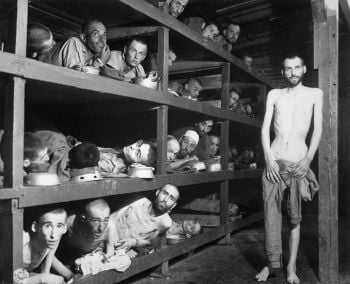
In 1939, Germany and the Soviet Union signed the Molotov-Ribbentrop Pact, which stipulated, amongst other things, the Soviet "interest" in Bessarabia. In 1940, Romania lost territory in both east and west: In June 1940, the Soviet Union occupied Bessarabia and northern Bukovina. Two thirds of Bessarabia were combined with a small part of the USSR to form the Moldavian SSR. Northern Bukovina and Budjak were apportioned to the Ukrainian SSR. In August 1940, Northern Transylvania was awarded to Hungary by Germany and Italy through the Second Vienna Award.
As a result of Carol II's having lost so much territory through failed diplomacy, General Ion Antonescu and the army seized Romanian leadership, forced Carol to abdicate, and crowned Carol's son Mihai king. Southern Dobruja was lost to Bulgaria shortly after Carol's abdication. For four months (the period of the National Legionary State) he had to share power with the Iron Guard, but the latter overplayed their hand in January 1941 and were suppressed.
Romania entered World War II under the command of the German Wehrmacht in June 1941, declaring war to the Soviet Union in order to recover Bessarabia and northern Bukovina. Romania was awarded the territory between Dniester and the Southern Bug by Germany to administer it under the name Transnistria.
According to a report released by the Romanian government in 2004, Antonescu's Fascist government was responsible for the deportations to concentration camps and executions (by the Romanian Army and Gendarmerie and the German Einsatzgruppen), of between 280,000 to 380,000 Jews in Romania and in the war zones of Bessarabia, Bukovina and Transnistria.
In August 1944, a coup led by King Mihai deposed the Antonescu dictatorship and put Romania's armies under Red Army command. Romania suffered additional heavy casualties fighting the Nazi Army in Hungary and Czechoslovakia.
The Paris Peace Treaty at the end of World War II rendered the Vienna Awards void: Northern Transylvania returned to Romania—having, for several years, an autonomous status that was eventually abolished—but Bessarabia, northern Bukovina and southern Dobruja were not recovered. The Moldavian SSR became independent of the Soviet Union only with the latter's 1991 demise, becoming the Republic of Moldova.
Soviet rule
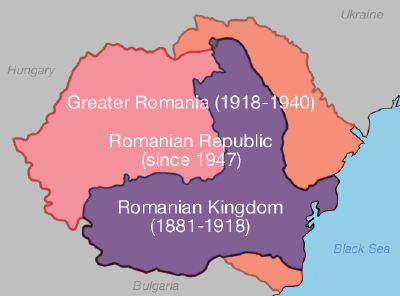
With the Red Army forces still stationed in the country and exerting control, Communists and their allied parties claimed 90 percent of the vote, through a combination of vote manipulation, elimination, and forced mergers of competing parties. In 1947, King Michael I was forced by the communists to abdicate and leave the country. Romania was proclaimed a republic, and remained under direct military and economic control of the USSR until the late 1950s.
During this period, Romania's resources were drained by mixed Soviet-Romanian companies, in addition to excessive war reparations paid to the USSR. A large number of people were arbitrarily imprisoned for political, economic or unknown reasons: detainees in prisons or camps, deported, persons under house arrest, and administrative detainees. Political prisoners were also detained as psychiatric patients. Estimations vary, from 60,000, 80,000, up to two million. There were hundreds of thousands of abuses, deaths and incidents of torture against a large range of people, from political opponents to ordinary citizens. Most political prisoners were freed in a series of amnesties between 1962 and 1964. Soviet troops left in 1958.
Ceauşescu regime
Nicolae Ceauşescu (1918–1989) became general secretary in 1965, and head of state in 1967. From 1958, Romania started to pursue independent policies, including the condemnation of the Soviet-led 1968 invasion of Czechoslovakia (Romania was the only Warsaw Pact country not to take part in the invasion), the continuation of diplomatic relations with Israel after the Six-Day War of 1967, and the establishment of economic (1963) and diplomatic (1967) relations with the Federal Republic of Germany. Close ties with the Arab countries (and the Palestinian Liberation Organization) allowed Romania to play a key role in the Israel-Egypt and Israel-PLO peace processes. A short-lived period of relative economic well-being and openness followed in the late 1960s and the beginning of the 1970s.
Ceauşescu's denunciation of the 1968 Soviet invasion of Czechoslovakia and a brief relaxation in internal repression helped give him a positive image both at home and in the West. Seduced by Ceauşescu's "independent" foreign policy, Western leaders were slow to turn against a regime that, by the late 1970s, had become increasingly harsh, arbitrary, and capricious.
As Romania's foreign debt sharply increased between 1977 and 1981 (from three to ten billion US dollars), the influence of international financial organizations such as the International Monetary Fund or the World Bank grew, conflicting with Nicolae Ceauşescu's despotic policies. Ceauşescu eventually initiated a project of total reimbursement of the foreign debt (completed in 1989, shortly before his overthrow). To achieve this goal, he imposed policies that impoverished Romanians and exhausted the Romanian economy. He profoundly deepened Romania's police state and imposed a cult of personality.
The Romanian Revolution of 1989 resulted in more than 1000 deaths in Timişoara and Bucharest, and brought about the fall of Ceauşescu and the end of the communist regime in Romania. After a weeklong state of unrest in Timişoara, a rally summoned in Bucharest in support of Ceauşescu on December 21, 1989, turned hostile. The Ceauşescu couple, fleeing Bucharest by helicopter, ended up in the custody of the army; after being tried and convicted by a kangaroo court for "genocide" and other crimes, they were executed on December 25, 1989. The events of this revolution remain a matter of debate, with numerous conflicting theories as to the motivations of some of the main players.
Romania since 1989
Ion Iliescu, a former Communist Party official marginalized by Ceauşescu, attained national recognition as the leader of an impromptu governing coalition, the National Salvation Front (FSN) that proclaimed the restoration of democracy and civil liberties on December 22, 1989. Iliescu initially outlawed the Communist Party, but he soon revoked that decision. However, Ceauşescu's most unpopular measures, such as bans on abortion and contraception, were among the first laws to be changed after the revolution.
Presidential and parliamentary elections were held on May 20, 1990. Running against representatives of the re-established pre-war National Peasants' Party and National Liberal Party, and taking advantage of FSN's tight control of the national radio and television, Iliescu won 85 percent of the vote, and secured two-thirds of the seats in Parliament. A university professor with strong family roots in the Communist Party, Petre Roman, was named prime minister of the new government, which consisted mainly of former communist officials. The government initiated modest free market reforms.
Because the majority of ministers in the Petre Roman government were ex-communists, anti-communist protesters initiated Golaniad around-the-clock anti-government demonstration in University Square, Bucharest, in April 1990. Two months later, these protesters, whom the government referred to as "hooligans," were brutally dispersed by the miners from Jiu Valley, called in by President Iliescu. This event became known as the mineriad. The miners also attacked the headquarters and private residences of opposition leaders. Petre Roman's government fell in late September 1991, when the miners returned to Bucharest to demand higher salaries. A technocrat, Theodor Stolojan, was appointed to head an interim government until new elections could be held.
In December 1991, a new constitution was drafted and subsequently adopted, after a referendum, which, however, attracted criticism from international observers. The constitution revised by a national referendum on October 18-19, 2003, again plagued by fraud accusations.)
The subsequent disintegration of the FSN produced several political parties including the Democratic Party (PD), the Romanian Democrat Social Party (PDSR, later Social Democratic Party, PSD), and the ApR (Alliance for Romania). The Socialist parties that emerged from the National Salvation Front (FSN) governed Romania from 1990 until 1996 through several coalitions and governments with Ion Iliescu as head of state. There have since been three democratic changes of government: In 1996, the democratic-liberal opposition and its leader Emil Constantinescu acceded to power; in 2000 the Social Democrats returned to power, with Iliescu once again president; and in 2004 Traian Băsescu was elected president, with an electoral coalition called Justice and Truth Alliance (DA). The government was formed by a larger coalition which also includes the Conservative Party and the ethnic Hungarian party.
On April 19th, 2007, the Romanian Parliament suspended President Traian Basescu on charges of unconstitutional conduct. The suspension, passed in a vote of 322 deputies to 108, opened the way for a national referendum on his impeachment.
Post-Cold War Romania developed closer ties with Western Europe, eventually joining NATO in 2004. The country applied in June 1993 for membership in the European Union (EU), became an associated state of the EU in 1995, an acceding country in 2004, and a member on January 1, 2007.
Government and politics
Romania is a semi-presidential democratic republic where executive functions are shared between the president and the prime minister. The president is elected by popular vote, and resides at Cotroceni Palace. Since the constitutional amendment of 2003, the president's term is five years (previously it was four).
A prime minister, who appoints the other members of his or her cabinet, and who is nearly always the head of the party or coalition that holds a majority in the parliament, heads the Romanian Government, which is based at Victoria Palace. If no party holds 50 percent + 1 of the total seats in parliament, the president will appoint the prime minister. Before beginning its term, the government is subject to a parliamentary vote of approval.
The legislative branch of the government, collectively known as the bicameral parliament of Romania (Parlamentul României), consists of two chambers – the Senate (Senat), which has 137 members, and the Chamber of Deputies (Camera Deputaţilor), which has 332 members. The members of both chambers are elected every four years under a system of party-list proportional representation. All aged 18 years and over may vote.
The justice system is independent of the other branches of government, and is made up of a hierarchical system of courts culminating in the High Court of Cassation and Justice. There are also courts of appeal, county courts and local courts. The Romanian judicial system is influenced by the French model, is based on civil law, and is inquisitorial in nature. The Constitutional Court (Curtea Constituţională) is responsible for judging the compliance of laws to the constitution, which was introduced in 1991, can only be amended by a public referendum. The Constitutional Court comprises nine judges who serve nine-year, non-renewable terms. The court's decisions cannot be overruled by any majority of the parliament.
The country's entry into the European Union in 2007 has been a significant influence on its domestic policy. As part of the process, Romania has instituted reforms including judicial reform, increased judicial cooperation with other member states, and taken steps to combat corruption.
Counties
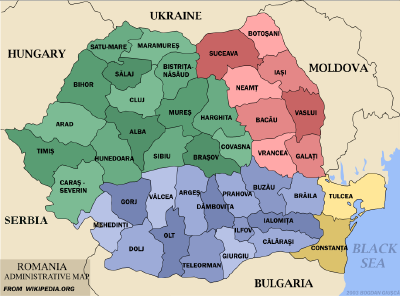
Romania is divided into 41 counties]] (judeţe), as well as the municipality of Bucharest, which is its own administrative unit. Each county is administered by a county council (consiliu judeţean), responsible for local affairs, as well as a prefect, who is appointed by the central government but cannot be a member of any political party.
Alongside the county structure, Romania is divided into eight development regions, which correspond to divisions in the European Union, and are used for co-ordinating regional development projects and for statistical purposes. The country is further subdivided into 2686 communes, which are rural localities, and 265 towns. Communes and towns have their own local councils and are headed by a mayor (primar). Larger and more urbanized towns gain the status of municipality, which gives them greater administrative power over local affairs.
Military
The Romanian Armed Forces (Forţele Armate Române or Armata Română) consists of three branches: Land, naval, and air forces. Since Romania joined NATO, extensive preparations have been made to abolish conscription and make the transition to a professional army by 2007, which would include 90,000 men and women. About 75,000 of these would be military personnel, while 15,000 would be made up of civilians. Sixty thousand would be active forces, while 30,000 would comprise the territorial forces
Economy
Romania has a large, upper-middle-income economy, the nineteenth largest in Europe by total nominal GDP and the fifteenth largest based on purchasing power parity. Its capital, Bucharest, is one of the largest financial centers in the region.
Romania is a country of considerable potential, with rich agricultural lands, diverse energy sources (coal, oil, natural gas, hydro, and nuclear), a substantial, if aging, industrial base encompassing almost the full range of manufacturing activities, a well-trained work force, and opportunities for expanded development in tourism on the Black Sea and in the mountains.
After the collapse of the Soviet Bloc in 1989-1991, Romania was left with an obsolete industrial base and a pattern of industrial capacity unsuited to its needs. In February 1997, Romania began macroeconomic stabilization and structural reforms, including the liquidation of large energy-intensive industries, and reforms of the agricultural and financial sectors.
However, macroeconomic gains have only recently started to spur creation of a middle class and address Romania's widespread poverty, while corruption and red tape continue to handicap the business environment. Romania revalued its currency in 2005, making 10,000 "old" lei equal to one "new" leu.
After a series of privatizations and reforms, government intervention in the Romanian economy is somewhat lower than in other European economies. In 2005, the liberal-democrat Tăriceanu government replaced Romania's progressive tax system with a flat tax of 16 percent for both personal income and corporate profit, resulting in the country having the lowest fiscal burden in the European Union, a factor that has contributed to the growth of the private sector.
Since 2000, Romania has become the single largest investment destination in south-eastern and Central Europe.
Services account for 55 percent of GDP, while industry and agriculture make up 35 percent and 10 percent of GDP, respectively. About 32 percent of the population is employed in agriculture and primary production, one of the highest rates in Europe.
Export commodities included textiles and footwear, metals and metal products, machinery and equipment, minerals and fuels, chemicals, agricultural products. Import commodities included machinery and equipment, fuels and minerals, chemicals, textile and products, basic metals, agricultural products.
Demographics
The 2011 census recorded that Romania had a population of 20,121,641 which has gently declined as a result of sub-replacement fertility rates. The population density of the country has doubled since 1900 although, in contrast to other central European states, and there is considerable room for further growth.
Ethnicity
Ethnic Romanians make up over 80 percent of the population. Before World War II, there was a large Jewish population, but almost 400,000 Jews were killed during the Nazi years, and many of the remainder emigrated to Israel. Today the Jewish population is estimated at less than 10,000. Estimates of the Roma population range from 400,000 to one million—their transient or nomadic lifestyle poses difficulties for statisticians.
The origin of the Romanians has long been disputed and there are two basic theories:
- Daco-Romanian continuity in Dacia and some adjacent regions.
- Migration of Romanic peoples from former Roman provinces south of the Danube in the Balkans.
The exact region where the Romanian language and people formed is not only a scientific puzzle, but also a heated political controversy. Nineteenth-century Hungarian historians largely supported the migration theory, which maintained that Transylvania was not inhabited by Romanians at the time of the Magyar arrival in central Europe during the tenth century. Most Romanian historians support the theory of Daco-Romanian continuity, and maintain that Transylvania was continuously inhabited by the ancestors of Romanians. The debate was politically charged in the nineteenth and twentieth centuries because of territorial conflicts concerning Transylvania between Romania and Hungary.
Language
The official language is Romanian, an Eastern Romance language, which has Latin roots that date back to the Roman occupation, and contains words from Greek, Slavic languages, and Turkish. In the fourteenth century, the country adopted the Cyrillic alphabet, but it later reverted to Roman lettering. Romanian is spoken as a first language by 91 percent of the population, with Hungarian and Romani being the most important minority languages, spoken by 6.7 percent and 1.1 percent respectively). Until the 1990s, there was also a substantial number of German-speaking Transylvanian Saxons, even though many have since emigrated to Germany. Serbian, Ukrainian, Slovak, Czech, Bulgarian, and Turkish is also spoken. In localities where a specific ethnic minority comprises more than 20 percent of the population, that minority's language can be used in the public administration and justice system, while native-language education and signage is also provided. English and French are the main foreign languages taught in schools.
Religion
Romania is a secular state with no state religion. The dominant religious body is the Romanian Orthodox Church, whose members make up 86.7 percent of the population according to the 2002 census. Other important religions include Roman Catholicism (4.7 percent), Protestantism (3.7 percent), Pentecostal denominations (1.5 percent) and the Romanian Greek-Catholic Church (0.9 percent). Romania has a significant Turkish Muslim minority of 67,500 people in Dobrudja. Based on the 2002 census data, there are also 6179 Jews, 23,105 people who are of no religion and/or atheist, and 11,734 who refused to answer.
Romanian Orthodoxy descends from the Great Schism between Eastern and Western Christianity of 1054, and has a more mystical slant than Roman Catholicism. Icons—images representing Christ, angels, saints, and other holy figures—are believed to be incarnations of the saint, and are considered a link between the physical and spiritual worlds.
Under communism, religion was suppressed, churches were destroyed, and clergy were arrested. The government restricted religious practice but did not forbid it. The Romanian Orthodox Church did not oppose the regime, and priests helped the administration. In 2006, President Traian Băsescu approved a new law under which religious denominations can only receive official registration if they have at least 20,000 members, or about 0.1 percent of Romania's total population.
The belief in vampires popularized in the nineteenth century story of Dracula, is a part of Romania folk culture. The belief is that sometimes the spirit does not leave the body after death, but remains, without decaying, to haunt the village, and can claim victims with a touch or a glance. Garlic is believed to keep vampires away, as are food offerings made on the holy days of Saint George and Saint Andrew. Mirrors are covered in the home of the deceased for fear that the spirit of the dead person will see its reflection and not be able to leave.
Men and women
The communist regime gave women equal rights in marriage and the workplace, and tried to get large numbers of women into the work force. While most women work outside the home, they have lower-level positions in traditional women’s jobs, such as primary school teachers or agricultural workers. Women who have a full-time job are expected to do all the cooking and cleaning at home. The Ceauşescu regime required women to have at least five children. Efforts to increase the population burdened women with unwanted children, and made many seek illegal and dangerous abortions. The government required gynecological examinations of women of childbearing age to prove that they had not had abortions. Already poor families could not afford to feed or clothe their children, and orphanages filled with abandoned babies.
Marriage and the family
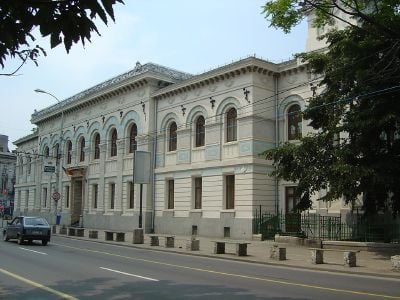
Traditionally, the couple's parents arranged marriages through a matchmaker, the bride's family contributed a dowry of linen and embroidery, and rural weddings involved the entire village. Today, young people choose their own spouses, although some traditions persist. The bride's hair is still elaborately braided, she wears a crown of flowers, jewels, and ribbons, and the groom wears a white leather vest and a hat decorated with feathers, flowers, and leaves. The best man shaves the groom's beard, symbolizing his departure to a new lifestyle, and in the ceremony, both ask their parents to forgive them for leaving. Wedding feasts include kegs of wine and a big round loaf of bread shared by the bride and groom.
Traditional families were large patriarchal units, with many family members available to work in the fields. The domestic unit still comprises several generations living together, which is also a result of housing shortages. The culture puts great value on helping members of the extended families, which allows accusations of nepotism. The Ceauşescu government was staffed by his relatives. Traditionally, an estate passes to the oldest son, although women are entitled to inherit property.
Regarding child care, the communist government established state-run day-care centers called crèches, where from a young age, children are left all day while their parents worked. Many crèches are overcrowded and under staffed.
Education
Education in Romania is free and compulsory from age six to 16. Children attend elementary school to age 14. After this, they must pass examinations to enter secondary school. About half these students go on to vocational schools; others continue their education at technical institutes or teacher-training programs.
Kindergarten is optional. Primary school comprises: Elementary school - grades one to four; and gymnasium school, grades five to eight. High school comprises four or five grades (grades nine to 13). Vocational education can continue or supplant high school to prepare students for careers that are based in manual or practical activities.
Higher education has the following four components: A bachelor degree, which takes three years in most disciplines; a master’s degree, which takes a further two years; a doctorate, which takes at least three years; and lifelong learning, which includes postgraduate education occurring outside the master/doctorate framework.
The largest and most prestigious university is the University of Bucharest, founded in 1864. Other centers of higher education include Babes-Blyai University in Cluj-Napoca and the Polytechnic Institute in Bucharest.
Romania has a high literacy rate—97.3 percent of the total population age 15 and over can read and write.
Class
Most people are poor, and the standard of living is low compared with Western Europe. Under the communist regime, a small elite had access to luxuries. Nicholae Ceauşescu lived in a 40-room palace decorated with artwork from churches and museums. Some of the old elite have retained their wealth and power. Cars, which are rare, and imported consumer goods and household appliances, which are expensive and difficult to come by, both symbolize status. The ability to send one's children to the best day-care centers and provide private tutoring is a mark of wealth.
Culture
The culture of Romania is rich and varied. The first half of the twentieth century is regarded as the golden age of Romanian culture. George Emil Palade, a cell biologist and a teacher, became the first Romanian to receive a Nobel Prize, winning the 1974 prize in physiology or medicine for describing the structure and function of organelles in cells. Elie Wiesel, a Romania-born American novelist, political activist, and Holocaust survivor, received the Nobel Peace Prize in 1986. Romanians are hospitable and generous—guests are always fed. Men show their respect for women by tipping the hat, kissing the hand, or offering a seat.
Architecture
The UNESCO List of World Heritage Sites includes the Saxon villages with fortified churches in Transylvania, the painted churches of northern Moldavia with their fine exterior and interior frescoes, the wooden churches of Maramures that combine Gothic style with traditional timber construction, the citadel of Sighişoara, and the Dacian Fortresses of the Orăştie Mountains.
The Saxon villages of Transylvania appeared in the thirteenth century when the Kings of Hungary settled German colonists in the area. Being constantly under the threat of the Ottoman and Tatar invasions, the colonists built fortifications against Tatar and Turkish invasions. The most important towns were fully fortified, and the smaller communities created fortifications centered around the church, where they added defensive towers and storehouses.
Wood was once the main construction material, and heavily ornamented wooden objects were common in old houses. In Maramureş, wood was used to create impressive structures such as churches or gates, in Dobruja, windmills were made of wood, and in mountainous regions hardwood was used for covering the roof. Houses in the countryside are two- or three-room wooden structures without plumbing or electricity, with roofs of red tiles, corrugated tin, or wooden shingles.
Some old architecture remains in Bucharest. Between the two world wars of the twentieth century, Bucharest was a cultural center called "the Paris of the East.” The communist regime replaced most old buildings with concrete apartment complexes, and its character has become more industrial and commercial. Urban dwellers live in high-rise apartment buildings, where conditions are cramped, and heating is often inadequate. The longest bridge in Europe was constructed by Anghel Saligny linking Dobruja with the rest of Romania.
Art
Romanian painters who rose to prominence in the nineteenth century after studying in Western Europe, include Nicolae Grigorescu, known for landscapes and rural life, and portrait painter Theodor Aman. Under the communist regime, social realism dominated as the government compelled artists to glorify industrial workers and political leaders. The most important artist who had a great influence on world culture was the sculptor Constantin Brâncuşi, a central figure of the modern movement and a pioneer of abstraction. He worked in wood and metal.
Clothing
City dwellers wear Western-style clothing, while in rural areas, some still wear traditional garb—embroidered wool skirts and vests for women, and a white blouse and pants with a wool or leather belt and a cap or hat for men. Roma people stand out in their brightly colored clothes. Women wear long flowing skirts, and men dress in white shirts with colorful sashes. Unmarried women wear their hair in traditional braids, while married women cover their heads with cloths.
Cuisine
An existential Romanian question is: Do we live to eat, or eat to live? A great number of proverbs and sayings have developed around the activity of eating. Romanian cuisine is diverse, greatly influenced by the cuisines of Germans, Serbians, and Hungarians. From Roman times there exists the simple pie called plăcintă in Romanian (placenta), the Turks have brought meatballs (Ciorbă in a meatball soup), from the Greeks there is moussaka, from the Bulgarians there are a wide variety of vegetable dishes like zacuscă,', and from the Austrians there is wiener schnitzel.
One of the most common dishes is mămăliga, a cornmeal mush, long-considered the poor man's dish. Pork is the main meat, but beef, lamb, and fish are also consumed. Different recipes are prepared depending on the season or for special events. For Christmas, a pig is traditionally sacrificed by every family to provide: cârnaţi (a kind of long sausages made with meat), caltaboşi (sausages made with liver and other intestines, piftie – made with the feet or the head and ears, suspended in aspic, and tochitură (a kind of stew) is served along with mămăligă and wine, and sweetened with the traditional cozonac (sweet bread with nuts or rahat). At Easter, the main dishes are roast lamb and drob - a cooked mix of intestines, meat and fresh vegetables, mainly green onion, served with pască (pie made with cottage cheese) as a sweetener.
Desserts include baclava (sweet pastry), covrigi (pretzels), gogoşi (donuts), halva, rahat (Turkish delight), plăcintă (pie), cozonac, pandişpan (sponge cake), orez cu lapte (rice pudding), crème caramel), and clătite (crêpes), among others.
Wine is the main drink and has a 3000-year tradition dating from the arrival of Greeks in Dacia. European varieties of grapes were introduced about 200 years ago. Romania is the world's ninth largest wine producer. A wide variety of domestic (Fetească, Grasă de Cotnar, Tămâioasă Românească) and worldwide (Italian riesling, merlot, sauvignon blanc, cabernet sauvignon, chardonnay, muscat ottonel) varieties are produced. Beer is highly regarded, generally blond pilsener beer.
Romania is the world's second largest plum producer and almost the entire plum production becomes the famous ţuică (a plum brandy).
Folk traditions
Romanian culture has strong folk traditions. Traditional folk arts include wood carving, ceramics, woven wool rugs, and embroidery of costumes, household decorations, dance, and richly varied folk music. Much folk art is preserved in the northwest region of Maramures. Doorways, gates, and windows are carved with elaborate designs. Traditional costumes are works of art, often displaying elaborate embroidery and a trimming of tiny glass beads.
Romanians have had numerous tales and poems about love, faith, kings, princesses, and witches. Ethnologists, poets, writers and historians have tried to collect and to preserve tales, poems, ballads. Customs related to certain times of year are the colinde - Romanian Christmas carols, sorcova on New Year's Eve, or the Mărţişor custom on the March 1 marking the spring. Other customs are presumably of pre-Christian pagan origin, like the Paparuda rain chanting custom in spring or early summer, or the masked folk theatre or Ursul (the bear) and Capra (the goat) in winter.
Literature
The national literature is rooted in early ballads, popular between the sixteenth and nineteenth centuries, which involved pastoral tales sung to the accompaniment of a lute or zither. The earliest surviving document in Romanian is a letter written in 1521, sent by Neacşu of Campulung to the jude (judge and mayor) of Braşov, Hans Benkner, warning of an Ottoman attack.
The earliest translations of books into Romanian were from Old Church Slavonic religious texts of the fifteenth century. The Psalter of Şcheia (Psaltirea Şcheiană) of 1482, and the Voroneţ Codex (Codicele Voroneţean) are religious texts that were written in Maramureş, probably with the help of the Hussite movement.
The first book printed in Romania was a Slavonic religious book in 1508. The first book printed in the Romanian language was a catechism of Deacon Coresi in 1559. Other translations from Greek and Slavonic books were printed later in the sixteenth century. Dosoftei, a Moldavian scholar, published in Poland in 1673, the first Romanian metrical psalter, producing the earliest known poetry written in Romanian.
Early efforts of publishing the Bible in Romanian started with the 1582 printing in the small town of Orăştie of the so-called Palia de la Orăştie - a translation of the first books of the Old Testament. The entire Bible was not published in Romanian until monks at the monastery of Snagov, near Bucharest, translated and printed "Biblia de la Bucureşti ("The Bucharest Bible") in 1688.
European humanism came to Moldavia in the seventeenth century via Poland with its great representative, Miron Costin, writing a chronicle on the history of Moldavia. Another humanist was Dimitrie Cantemir, who wrote histories of Romania and Moldavia.
During Ottoman rule, through Greek merchants of Istanbul, Greek culture influenced Romanian literature. For example, one of the greatest poets of the eighteenth century was Alecu Văcărescu, who wrote love songs in the tradition of ancient Greek poet Anacreon. His father, Ienăchiţă Văcărescu, was a poet as well, but he also wrote the first Romanian grammar and his son, Iancu Văcărescu, was probably one of the greatest poets of his generation.
Many nineteenth century Romanian writers participated in the revolutions of 1821 and 1848. In Transylvania, a Latinist movement Şcoala Ardeleană emerged, producing philological studies about the Romanic origin of Romanian, and opening Romanian language schools. Ion Creanga (1837/1839 — December 31, 1889) was famous for his use of traditional storytelling techniques in fiction and memoirs. Vasile Alecsandri (1821 – 1890), a prolific writer, contributed poetry, prose, several plays, and collections of Romanian folklore. Mihai Eminescu wrote lyric poetry rooted in Romanian traditions, but was also influenced by German philosophy and Hindu traditions.
After achieving national unity in 1918, Romanian literature entered what can be called a golden age, characterized by the development of the Romanian novel. Political events influenced works such as Liviu Rebreanu's Răscoala ("The Uprising"), which, published in 1932, was inspired by the 1907 Romanian Peasants' Revolt, and Pădurea Spânzuraţilor ("The Forest of the Hanged"), published in 1922, and inspired by World War I.
The communist era brought socialist realism, when the government compelled writers to glorify factory workers and political leaders. Romanian writers made contributions abroad. Tristan Tzara, who left for France during World War I, helped found the Dadaist movement. Eugene Ionesco (1912–1994), also lived in France and wrote in French, composed the famous absurdist dramas The Rhinoceros and The Bald Soprano.
Music
Romanians consider their doina (a sad song either about one's home or about love, composed like an epic ballad) unique in the world. Maria Tănase is considered to be one of the greatest Romanian folk singers, and Grigore Leşe and Taraful Haiducilor are two of the most famous musicians. The hora is a group circle dance. The men's folk dances, including the căluşari, have been declared by UNESCO to be masterpieces.
Pianist and conductor Dinu Lipatt and Georges Enesco, a violinist and composer, whose work was influenced by traditional folk songs, have achieved prominence in classical music.
Also jazz and blues, and, to an extent, eurodance/trance music and heavy metal/punk are popular, especially in large cities. A Turkish influenced music style called manele is popular in working-class districts of cities and in villages.
Theatre and cinema
During the communist period, there was a significant increase in the number of theaters. In the big cities they became landmarks, such as the National Theatre of Bucharest, situated right in the middle of the city. In the smaller towns, there existed the so-called "Worker's Theatre," a semi-professional institution. Partly due to the lack of other entertainment, theatre was popular and the number of actors increased. Every theater had a stable, state-funded budget, but they were under heavy state control, tight censorship, and only ideologically-accepted plays were allowed. More progressive theaters managed to survive in remote cities, but they generally had only a local audience.
Cinemas evolved the same way as the theaters; sometimes the same establishment served both purposes. Movies were popular, and from the 1960s, foreign films were widely available. Western films were heavily censored: entire sections were cut, and dialogue was translated only using ideologically accepted words. Domestic or "friendly" foreign productions constituted the bulk of films in cinemas. During this period, cinematography started to develop in Romania and the first successful short films were made based on Ion Luca Caragiale plays. Financed by the government, during the 1960s, a whole industry developed at Buftea, a town close to Bucharest, and some films, especially gangster, Western-genre and historical movies were well received. The most prolific director was Sergiu Nicolaescu, and probably the most-acclaimed actor from that period was Amza Pellea.
Sport
In the 1976 Summer Olympics, the gymnast Nadia Comăneci became the first gymnast ever to score a perfect "10", and won three gold medals, one silver and one bronze, all at the age of 15. Her success continued in the 1980 Summer Olympics, where she was awarded two gold medals and two silver medals. Ilie Năstase, the tennis player, is another internationally known Romanian sports star. He won several Grand Slam titles and dozens of other tournaments, and was a successful doubles player. Romania has reached the Davis Cup finals three times. Virginia Ruzici was a successful tennis player in the 1970s.
Football (soccer) is popular, the most internationally known player being Gheorghe Hagi, who played for Steaua Bucureşti (Romania), Real Madrid, FC Barcelona (Spain) and Galatasaray (Turkey), among others. In 1986, the Romanian soccer club Steaua Bucureşti became the first Eastern European club ever to win the prestigious European Champions Cup title. Though maybe not the force they once were, the Romanian national rugby team has so far competed at every Rugby World Cup.
Notes
- ↑ CIA, Romania World Factbook. Retrieved December 22, 2021.
- ↑ Robert Elgie, Political Leadership: A Pragmatic Institutionalist Approach (Palgrave Macmillan, 2017, ISBN 978-1137346216).
- ↑ Populația rezidentă la 1 Ianuarie 2021 National Institute of Statistics (Romania). Retrieved December 22, 2021.
- ↑ 4.0 4.1 4.2 4.3 World Economic Outlook Database, April 2021 Edition International Monetary Fund. Retrieved December 22, 2021.
- ↑ Gini coefficient of equivalised disposable income – EU-SILC survey Eurostat. Retrieved December 22, 2021.
ReferencesISBN links support NWE through referral fees
- Balas, Egon.Will to Freedom: A Perilous Journey Through Fascism and Communism. Syracuse University Press, 2008. ISBN 978-0815609308
- Chirot, Daniel. Modern Tyrants: The Power and Prevalence of Evil in our Age. New York: Free Press, 1994. ISBN 9780029054772
- Elgie, Robert. Political Leadership: A Pragmatic Institutionalist Approach. Palgrave Macmillan, 2017. ISBN 978-1137346216
- Pop, Ioan Aurel. Romanians and Romania: A Brief History. Boulder: East European Monographs, 1999. ISBN 0880334401
- Roper, Steven D. Romania: The Unfinished Revolution. Routledge, 2000. ISBN 9058230287
- Shen, Raphael. The Restructuring of Romania's Economy: A Paradigm of Flexibility and Adaptability. Westport, CT: Praeger, 1997. ISBN 0275956946
- Stowe, Debbie. Romania - Culture Smart!: a quick guide to customs and etiquette. London: Kuperard, 2008. ISBN 1857334523
- Treptow, Kurt W., and Ioan Bolovan. A History of Romania. Boulder, CO: East European Monographs, 1996. ISBN 0880333456
External links
All links retrieved December 15, 2022.
- World Factbook. Romania.
- Countries and Their Cultures. Cultures of Romania.
- U.S. Department of State. Romania.
- British Broadcasting Corporation. Romania Country Profile.
Credits
New World Encyclopedia writers and editors rewrote and completed the Wikipedia article in accordance with New World Encyclopedia standards. This article abides by terms of the Creative Commons CC-by-sa 3.0 License (CC-by-sa), which may be used and disseminated with proper attribution. Credit is due under the terms of this license that can reference both the New World Encyclopedia contributors and the selfless volunteer contributors of the Wikimedia Foundation. To cite this article click here for a list of acceptable citing formats.The history of earlier contributions by wikipedians is accessible to researchers here:
- Romania history
- Geography_of_Romania history
- Bucharest history
- History_of_Romania history
- Prehistoric_Romania history
- Thracians history
- Nicolae_Ceauşescu history
- Ion_Iliescu history
- Politics_in_Romania history
- Economy_of_Romania history
- Romanian_Armed_Forces history
- Romanian_cuisine history
- Demographics_of_Romania history
- Origin_of_the_Romanians history
- Romanian_educational_system history
- Culture_of_Romania history
The history of this article since it was imported to New World Encyclopedia:
Note: Some restrictions may apply to use of individual images which are separately licensed.


